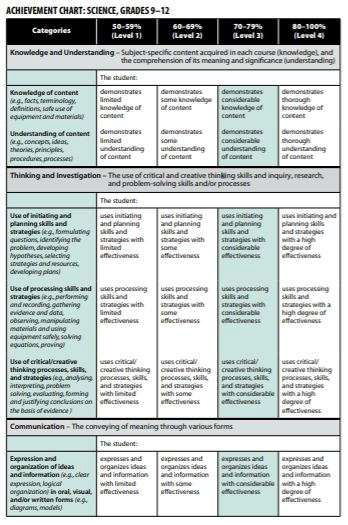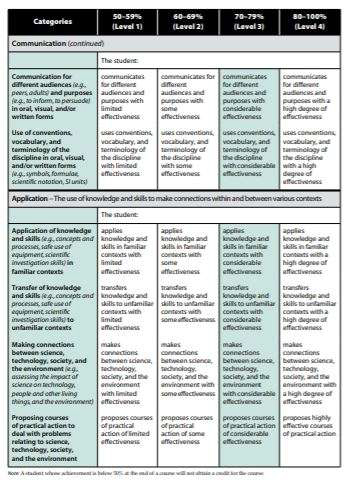Course Description
This course enables students to deepen their understanding of physics concepts and theories. Students will continue their exploration of energy transformations and the forces that affect motion, and will investigate electrical, gravitational, and magnetic fields and electromagnetic radiation. Students will also explore the wave nature of light, quantum mechanics, and special relativity. They will further develop their scientific investigation skills, learning, for example, how to analyse, qualitatively and quantitatively, data related to a variety of physics concepts and principles. Students will also consider the impact of technological applications of physics on society and the environment.
Course Code: SPH4U
Course Name: Physics Grade 12, University Preparation
Department: Science
Hours: 110
Credit Value: 1.0
Pre-requisites: Physics Grade 11, University Preparation
Curriculum Policy Documents: The Ontario Curriculum, Science: Grades 11 and 12. 2007.
Growing Success: Assessment, Evaluation, and Reporting in Ontario School. 2010.
Development Date: August 2019
Developed By: Kelda Wells
Overall Curriculum Expectations
- demonstrate scientific investigation skills (related to both inquiry and research) in the four areas of skills (initiating and planning, performing and recording, analyzing and interpreting, and communicating).
- identify and describe careers related to the fields of science under study, and describe the contributions of scientists, including Canadians, to those fields.
- analyze technological devices that apply the principles of the dynamics of motion, and assess the technologies’ social and environmental impact.
- investigate, in qualitative and quantitative terms, forces involved in uniform circular motion and motion in a plane, and solve related problems.
- demonstrate an understanding of the forces involved in uniform circular motion and motion in a plane.
- analyze, and propose ways to improve, technologies or procedures that apply principles related to energy and momentum, and assess the social and environmental impact of these technologies or procedures.
- investigate, in qualitative and quantitative terms, through laboratory inquiry or computer simulation, the relationship between the laws of conservation of energy and conservation of momentum, and solve related problems.
- demonstrate an understanding of work, energy, momentum, and the laws of conservation of energy and conservation of momentum, in one and two dimensions.
- analyse the operation of technologies that use gravitational, electric, or magnetic fields, and assess the technologies’ social and environmental impact.
- investigate, in qualitative and quantitative terms, gravitational, electric, and magnetic fields, and solve related problems.
- demonstrate an understanding of the concepts, properties, principles, and laws related to gravitational, electric, and magnetic fields and their interactions with matter.
- analyse technologies that use the wave nature of light, and assess their impact on society and the environment.
- investigate, in qualitative and quantitative terms, the properties of waves and light, and solve related problems.
- demonstrate an understanding of the properties of waves and light in relation to diffraction, refraction, interference, and polarization.
- analyse, with reference to quantum mechanics and relativity, how the introduction of new conceptual models and theories can influence and/or change scientific thought and lead to the development of new technologies.
- investigate special relativity and quantum mechanics, and solve related problems.
- demonstrate an understanding of the evidence that supports the basic concepts of quantum mechanics and Einstein’s theory of special relativity.
Course Content
| Unit | Unit Title | Approx. Duration |
| Unit 1 | Dynamics and Kinematics | 25 hours |
| Unit 2 | Energy and Momentum | 25 hours |
| Unit 3 | Gravitational, Electric, and Magnetic Fields | 25 hours |
| Unit 4 | Light and Relativity | 25 hours |
| Laboratory Experiment | Formal Lab Report | 7 hours |
| Final Examination | 3 hours | |
| TOTAL | 110 hours | |
Evaluation Breakdown
| Evaluation Type | Percentage of Final Grade |
| Test 1 | 15% |
| Test 2 | 15% |
| Test 3 | 15% |
| Test 4 | 15% |
| Laboratory Investigation and Formal Lab Report | 10% |
| Final Exam | 30% |
| Total | 100% |
Achievement Chart
The following table provides a summary description of achievement in each percentage grade range and corresponding level of achievement:


Program Planning Considerations
- Modelling of expectations
- Reference to and use of online ESL and subject-specific and dictionaries
- Concrete examples and materials whenever possible
- Use of a variety of learning resources including visual material and cues, , graphic organizers and visual
- Materials that reflect cultural diversity
- Pre-writing strategies
- Previewing course readings / texts
- Community Connections
- Environmental Perspective
- Simulation
- Problem Solving
- Surveys
- Co-operative Learning
- Inquiry-based learning
- Cross-curricular connections
- think critically about themselves and others in the world around them in order to promote fairness, healthy relationships, and active responsible citizenship.
- work to high standards, as it affirms the worth of all students, and helps students strengthen their sense of identity and develop a positive self-image.
- value and show respect for diversity.
- Developing a learning environment where all students feel safe
- Promotion of diversity and inclusivity in the classroom
- Getting students involved within their school community
- Making community connections
- Peer tutoring
- Role playing
- Group discussion
- Case Study analysis
- Making community connections
- Peer tutoring
- Role playing
- Group discussions
- Case study analysis
- Simulation
- Problem solving
- Cross-curricular connections
- Media connections
- Surveys and interviews
- Model ethical behavior
- Explore ethical standards
- Explore ethical concerns
- Inclusive practices
- Foster positive relationships with others
- Assist students in developing an understanding of ethical judgments
- Assist students in understanding confidentiality standards
- Community connections
- Simulation
- Problem Solving
- Inquiry-based learning
- Cross-curricular connections
- Issue-based analysis
- Critical literacy skills
- Setting financial goals
- Developing intra-personal skills
- Reading, interpreting, and analysing various texts, including diaries, letters, government legislation and policy documents, interviews, speeches, information from non-governmental organizations, news stories, and fiction and non-fiction books
- Extracting information
- Analysing various types of maps and digital representations, including charts, diagrams, pictures, etc.
- Using appropriate and correct terminology, including that related to the concepts of disciplinary thinking
- Making community connections
- Peer tutoring
- Role playing
- Group discussions
- Case study analysis
- Simulation
- Problem solving
- Cross-curricular connections
- Media connections
- Kinesthetic opportunities
- Foster use of proper terminology
- Inquiry and research skills
- Help students to develop a language for literacy, inquiry and numeracy skills
- Assist students with developing communication skills in areas of literacy, inquiry and numeracy
- Experiential Learning: Library visits, Guest Speaker, Role Playing, mock trials, writing anthology, author visits, writers reading, theatre workshops
